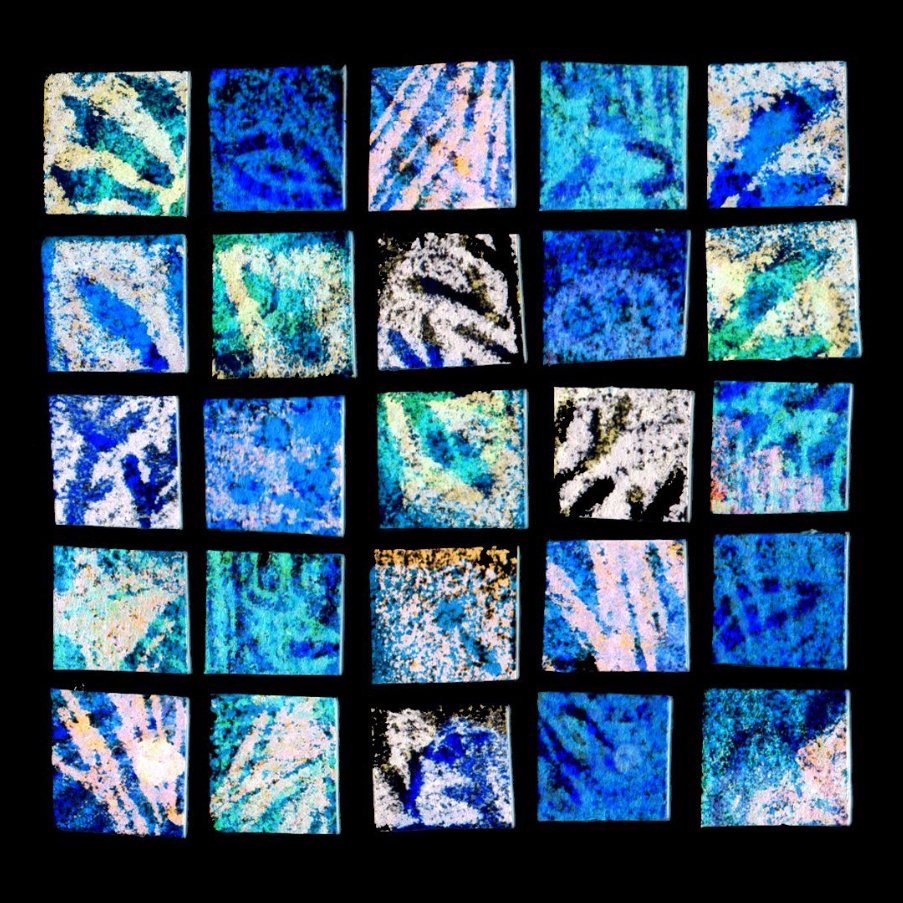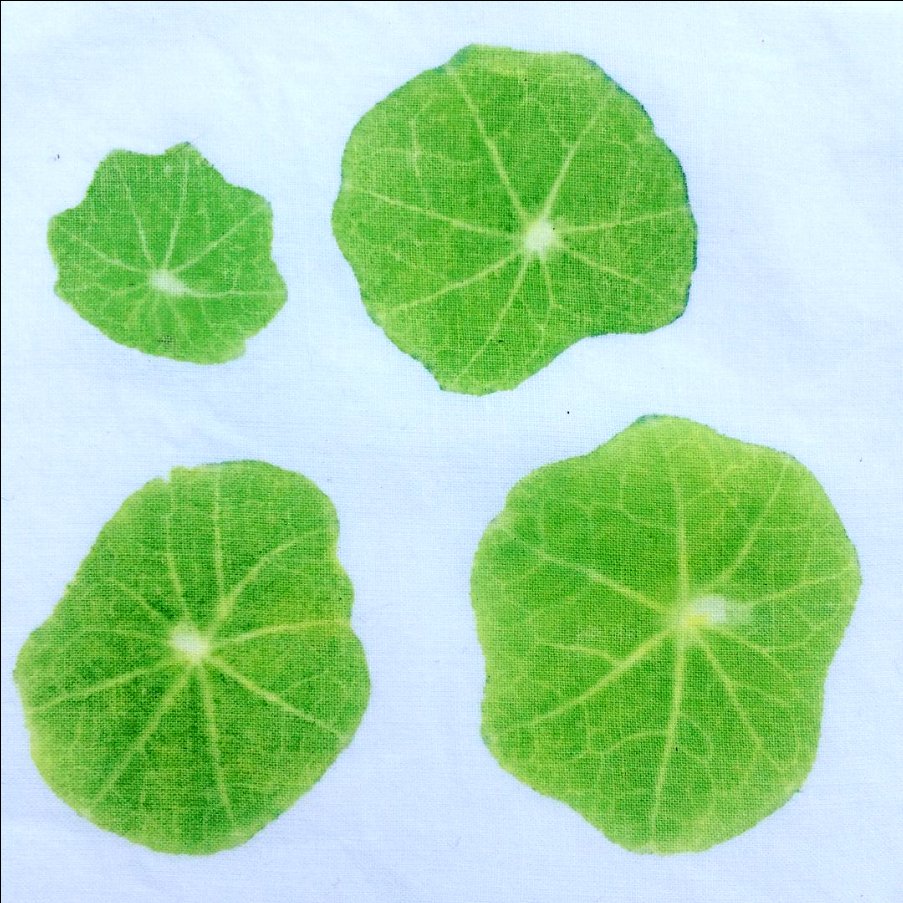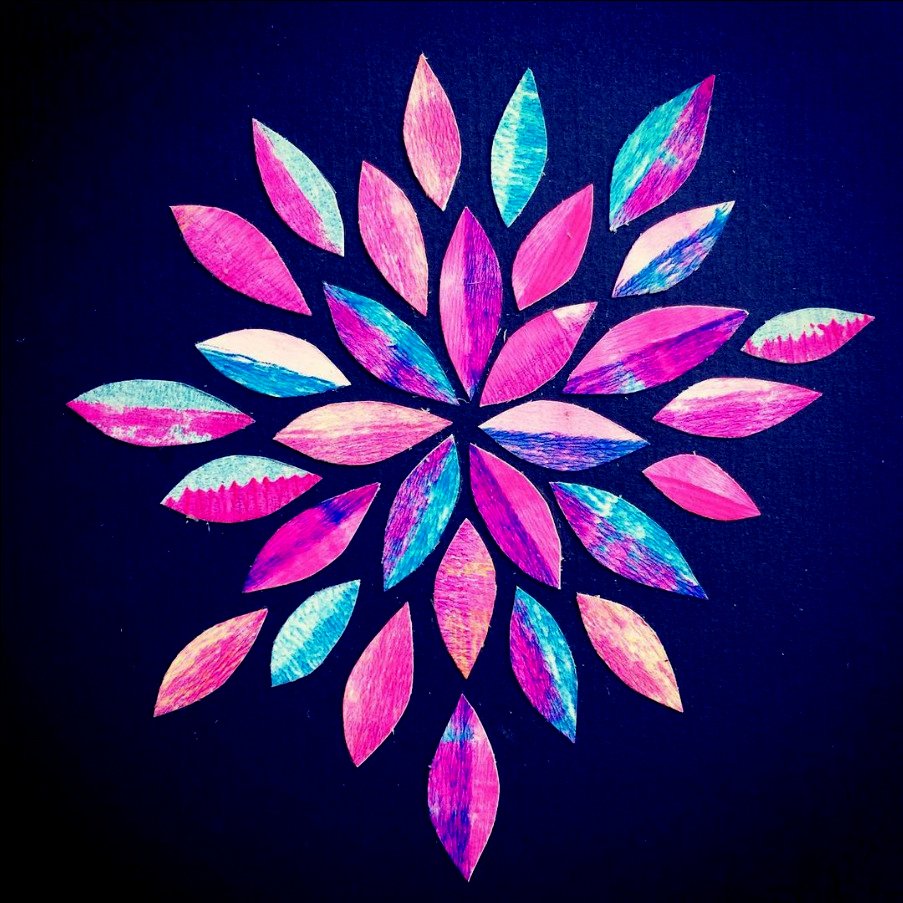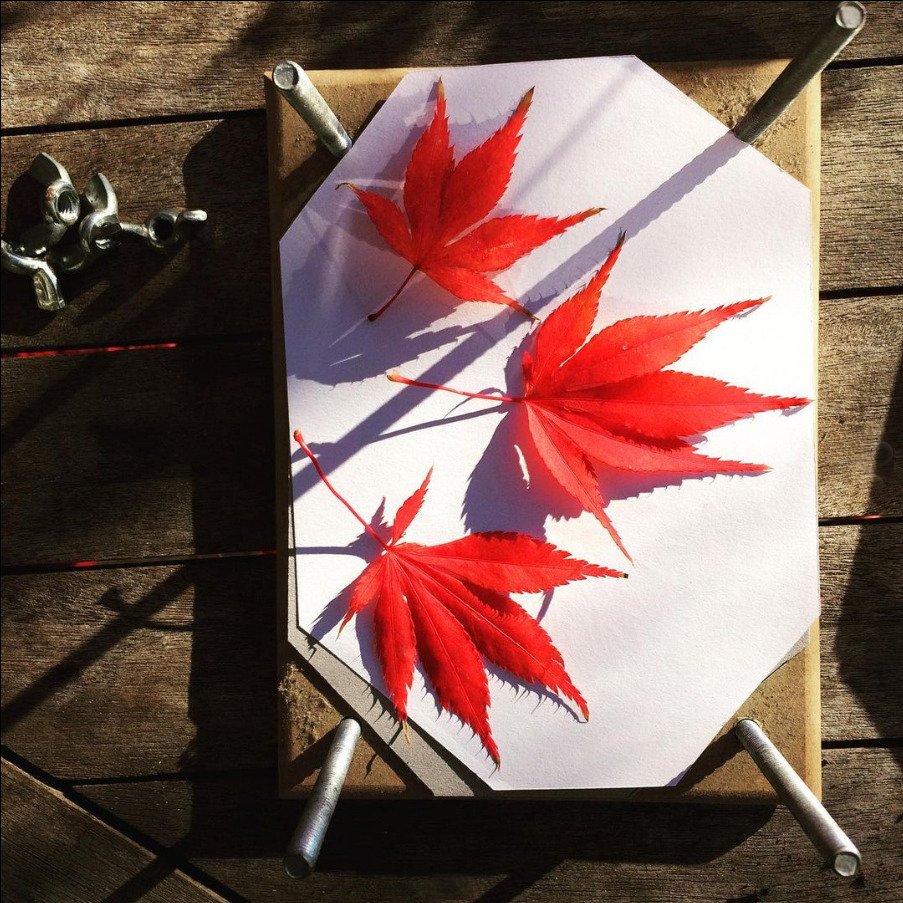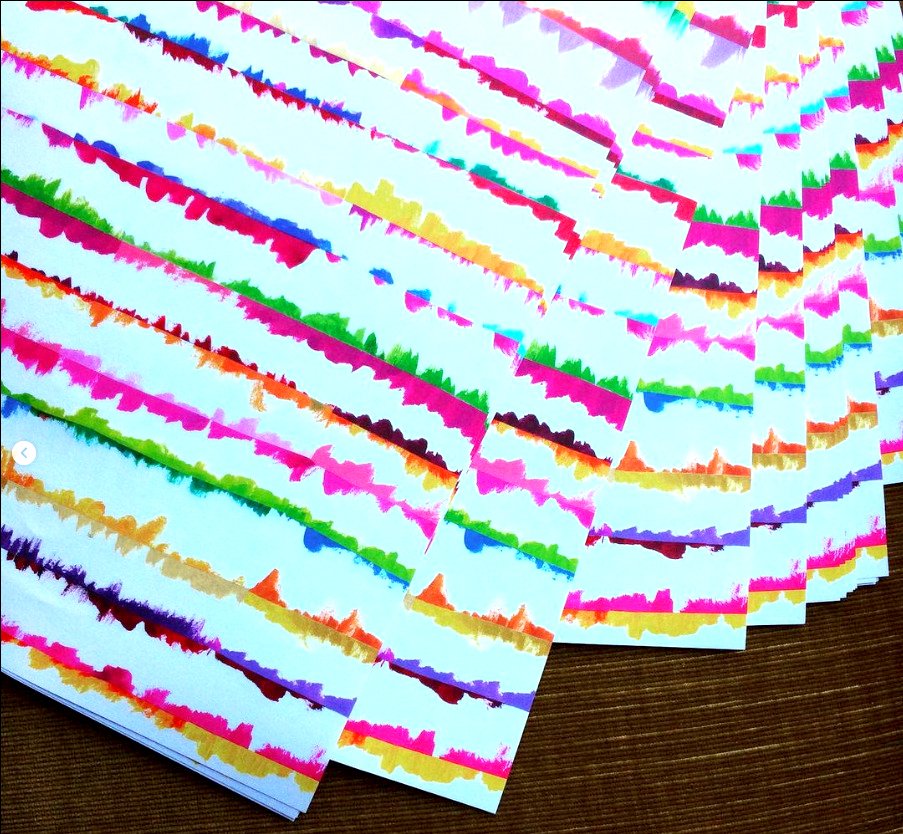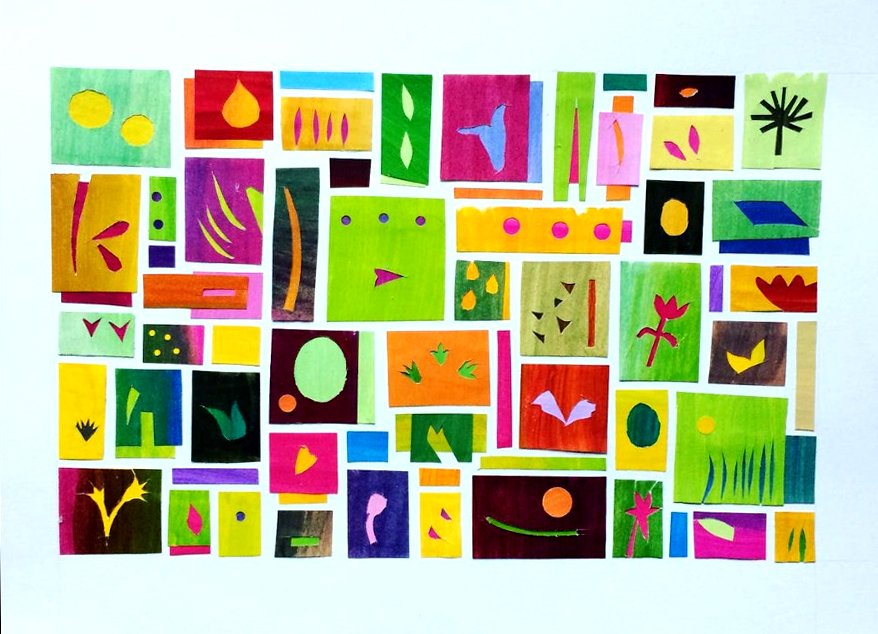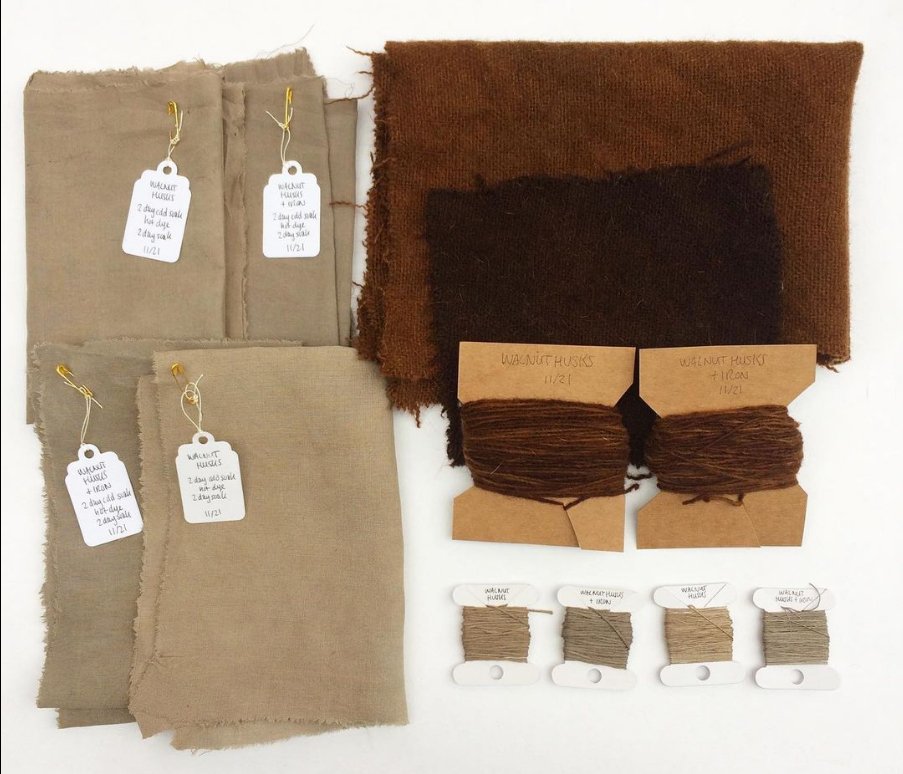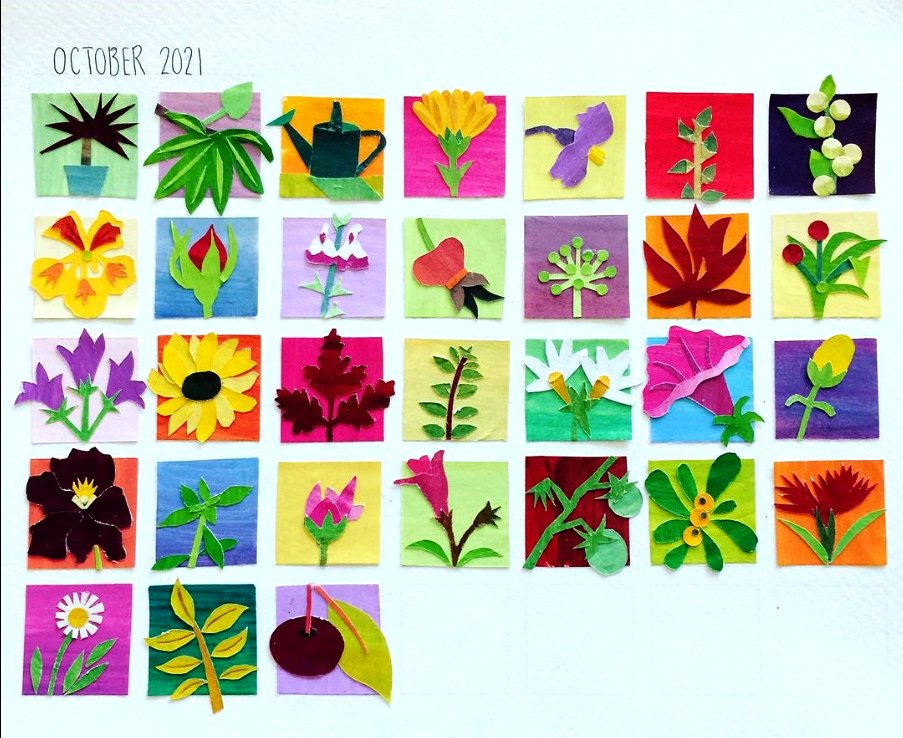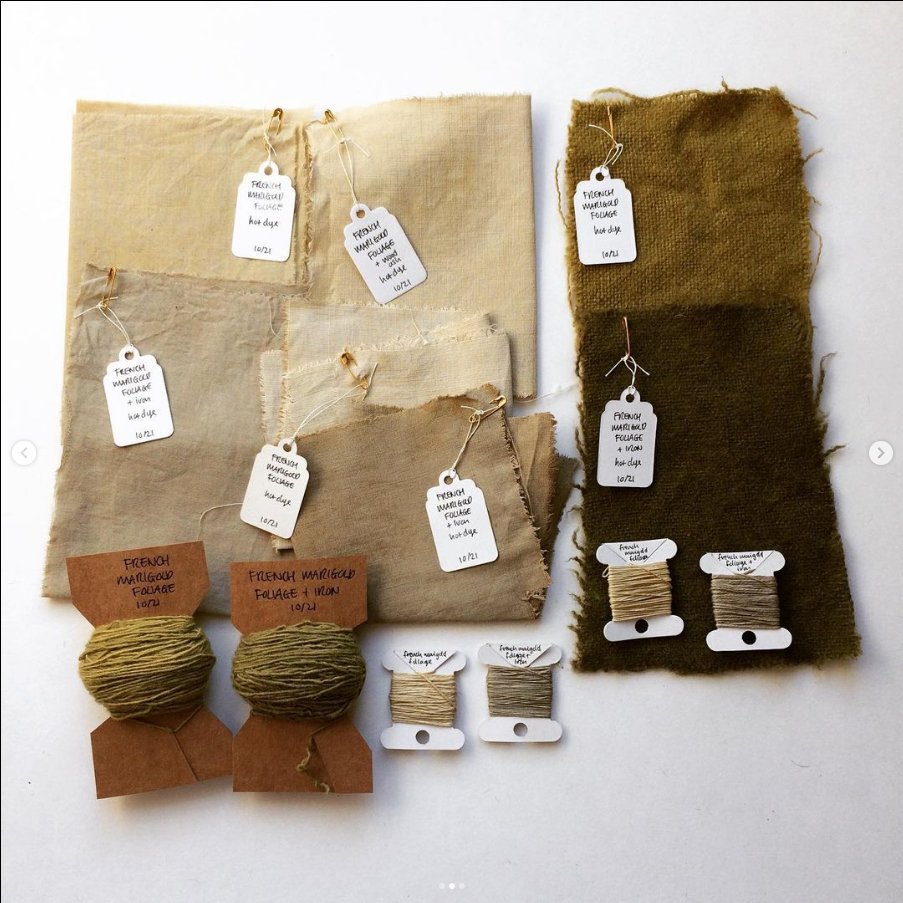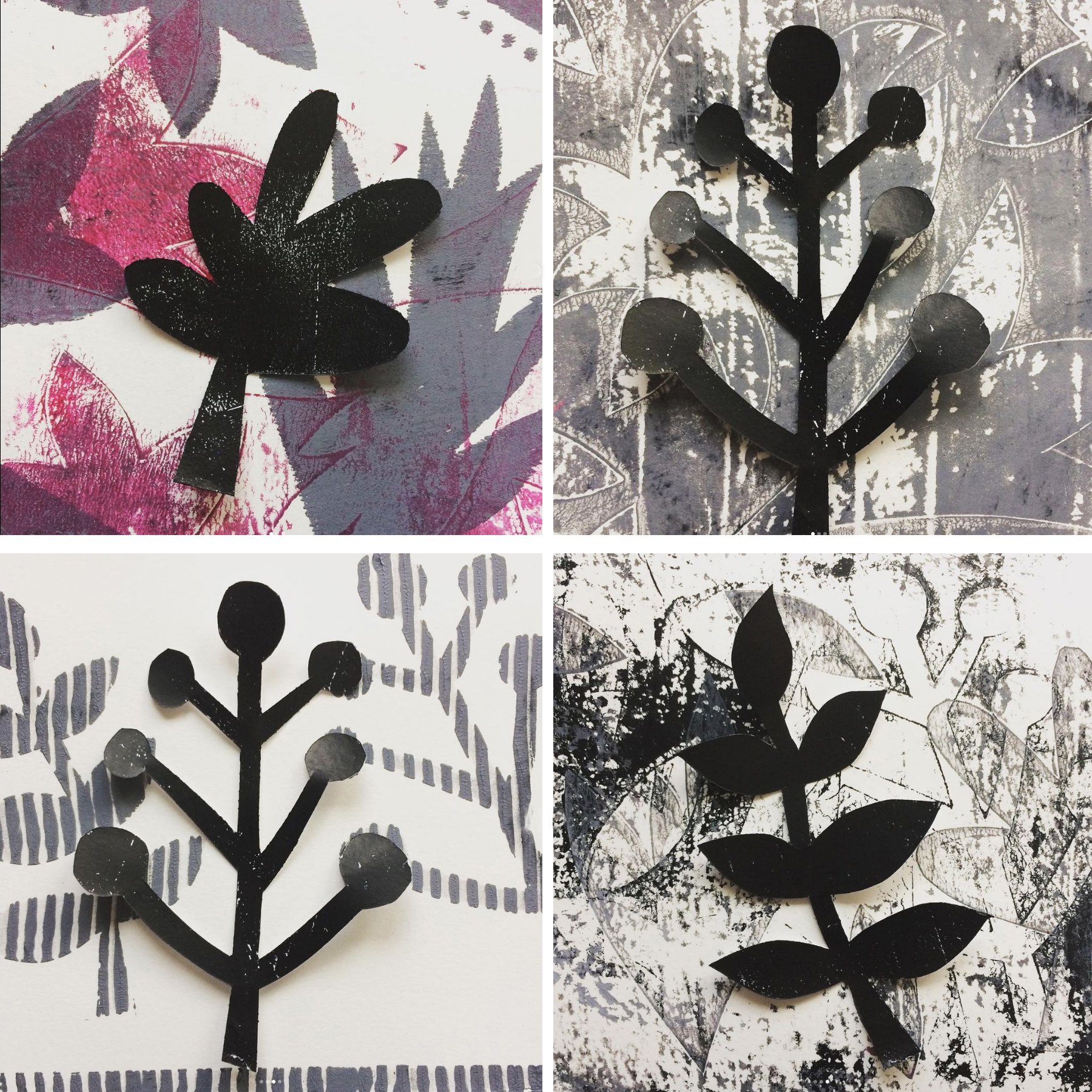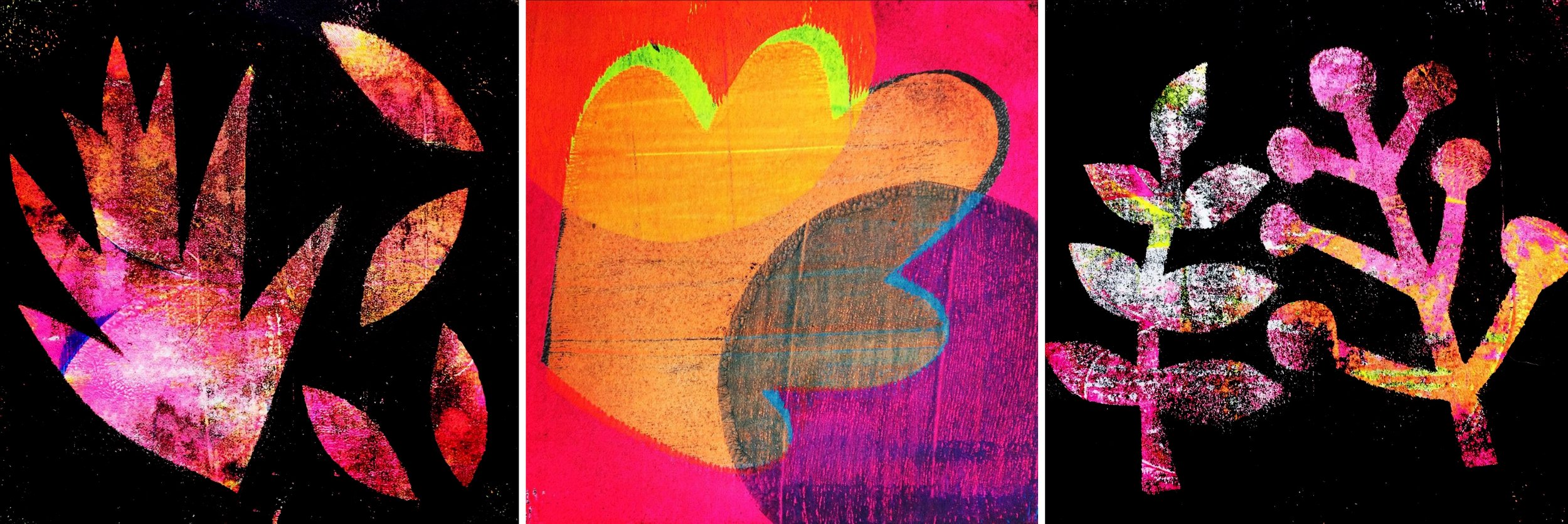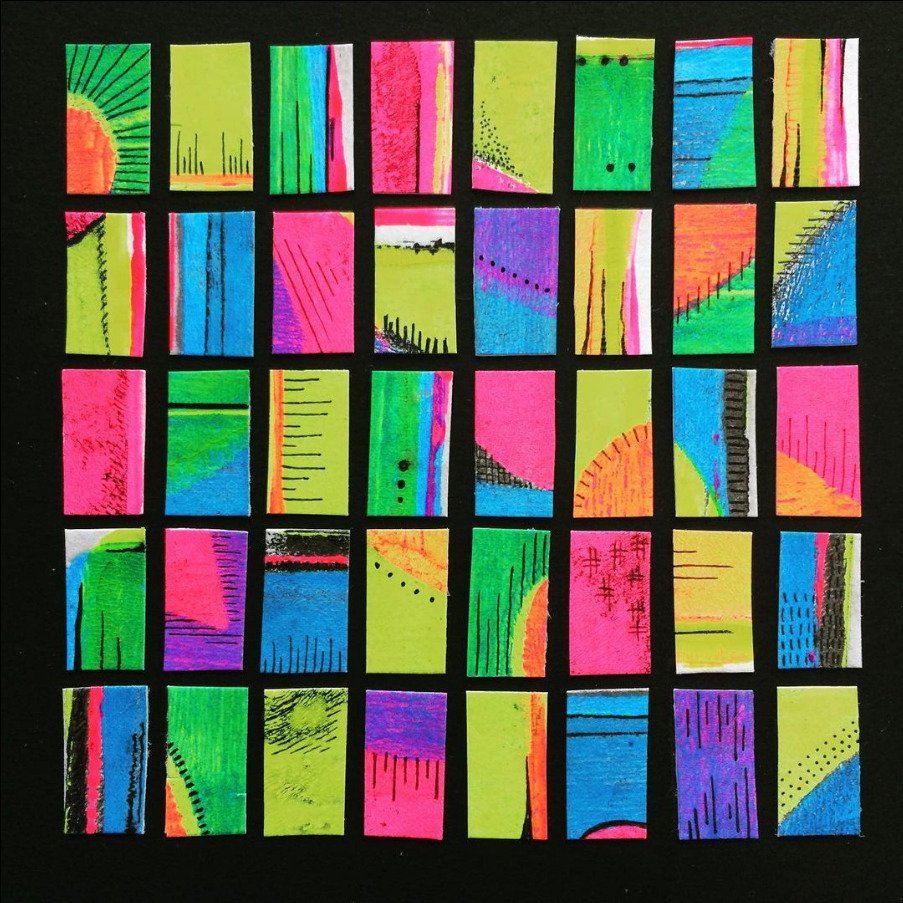I’ve been finishing off recording my 2021 garden residency (and enjoying taking my foot off the pedal a little). Looking forward to developing some of the pieces in these sketchbooks over the next few months...
Week fifty two
And so ends the Garden Residency 2021!
One final collage of offcuts for the year
My small article in the latest issue of Printmaking Today
Penultimate dye experiment of the year – Yarrow (achillea)
December’s daily drawings - back-drawn monoprints with natural ink
And so ends my 2021 Garden Residency... it’s been a diversion, an excuse to experiment, some much needed structure, and license to play. A creative sabbatical. Accompanied throughout by my trusty studio assistant, Otto (a Vizsla of senior years).
One final collage of monoprinting offcuts before the year came to a close. If in doubt, cut out circles and arrange them in a grid. Always a useful creative un-blocker.
My last two dye experiments of the year are out of the dyepot... that makes 55 in total. Shown here is Yarrow (achillea) and I have Teasel drying at the moment. To be honest the colour palettes are very similar. A rather unexceptional end to a year of colour creation, but I’m looking forward to using some of the dyed fabric, yarn and thread from my dye experiments in new work next year.
In a piece of perfect timing, I received some exciting post on the penultimate day of this year-long project. I’m thrilled to bits to have a small piece on my garden residency in the latest Printmaking Today magazine. Many thanks to editor Leonie Bradley for including me in this issue.
My final month of daily drawings... 31 days of (rather splodgy) back-drawn monoprints coloured with natural ink (mostly marigold, black dahlia and oak twigs). As with all of the other eleven sheets, it’s interesting to see the overall effect as they accumulate through the month, rather than focusing on one drawing in particular.
I’m pleased to have completed my year-long challenge of a drawing a day, and I think I may have unintentionally made it into a habit (although I may reduce it to just weekdays as this is easier to build into my work schedule). Here’s to more drawing in 2022!
Amongst many other things, this Garden Residency has been a useful exercise in maintaining a weekly blog entry – based on my many Instagram posts throughout the year. I’ve really appreciated all the words of support, encouragement and feedback – it’s been a good way of feeling more connected during an otherwise isolated year.
I now need to finish recording my work in my journal, and take some time to consolidate and reflect, before working out my next steps. In the meantime, wishing everyone a happy and healthy new year... x
Week fifty one
Pressed (and nibbled) Geranium leaves
Sunflower dye results
My Christmas card this year
I’ve uncovered some weird and wonderful geranium leaves out of the flowerpress. Not sure what had been nibbling them to create such impressive doilification (is that a word?!) I’ll store these to make some cyanotypes next year when the sun makes a welcome return.
A soft range of colours from dyeing sunflower heads. More like the seeds than the flowers. These were a pretty standard variety, but I also attempted to grow black Hopi sunflowers (meant to be excellent for dyeing) this year after @sixhq kindly sent me some seeds back in the Spring. Even in pots on gravel, they proved irresistible to the slugs, but I managed to at least grow enough to collect more seed to try again next year.
This is my Christmas card this year – a (slightly doctored) cyanotype of hydrangea petal skeletons from my garden. Made in summer but it felt suitably wintery. Wishing everyone reading this a very relaxing and festive season wherever you are (and whatever restrictions you may be facing).
Week fifty
A leaf rubbing stitched with dyed linen thread
The four stages of the dye process (see below for details)
Coreopsis dye results
Playing around with my small stash of pressed leaves. I made a rubbing of a passionflower leaf, coloured it with an ink stamp pad, then cut it out and stitched it onto some Somerset paper using linen thread (dyed with carrot tops). Many of the leaves are too fragile to incorporate directly, but making rubbings seems to be a good way of reproducing them... more experiments needed!
I’ve been trying to clear some space in the freezer before Christmas, so there’s a flurry of dyeing activity, mostly with frozen flowerheads. I realised the different pans sat on my decking illustrated the various stages of the dye process:
1. Dried teasels soaking in water ready to be boiled into dye
2. Yarrow just boiled up, waiting to cool down before being strained
3. Strained sunflower dye with fabric, thread and yarn, cold soaking for a day before being heated up
4. Spent coreopsis dyebath, ready to be boiled down into ink
Finally, a welcome pop of colour on a grey December day – the results of dyeing with coreopsis. Gorgeous yellow flowers, deadheaded over the summer (and stashed in my freezer). They make a lovely range of oranges (turning brown with iron oxide). Something quite magical about creating colour in winter from flowers collected in sunnier times...
Week forty nine
Paper stencils from November’s polyprints
Collage of chopped up test sheets from polyprints
Another polyprint test sheet collage
And an inverse image in Photoshop
Dye results from iris tubers
I kept the paper stencils cut for November’s polyprints. I really like the chunky quality of the shapes and would like to use this as a starting point for new work. Maybe a woodcut? Or an embroidery? Or even another collage?
Using up more waste material… I chopped up the test sheets from last month’s polyprints... interesting colour combinations and texture. I inversed one of the scans in Photoshop and I was fascinated by how different it looks when the colour palette is altered.
I’d read that dye could be made from iris root (tubers)... I was moving some irises from the front garden, so decided to test it out. Not quite the colour punch I was hoping for, but some pleasant-enough teddy bear browns in the yarn and woollen blanket (looks a bit more ochre in this photo than it does in real life).
Week forty eight
Polyprinted daily drawings for November
Random print with leftover, used polyprint plates
Collage made from filter paper from making black dahlia ink
November’s sheet of daily drawings are now complete – this month I made polyprints (using plates similar to frozen pizza base packaging). I have a lot less control and the results are a lot more rough and ready than I’m used to, but I’ve really enjoyed the challenge of working out the potential of this ultra low tech form of printmaking.
I used the leftover, used polyprint plates to make a random grid print of overlays – interesting to see the unexpected textures that emerge from working like this. I’d definitely like to experiment more with polyprints in the future.
The coffee filter paper used for making my black dahlia ink a ouple of weeks ago was too enticing to throw away. Instead I made a small collage of a dahlia, with the background painted with the actual black dahlia ink.
Week forty seven
Hapazome print of nasturtium leaves
Hapazome print of acer leaves
Recent natural ink results
Offcuts collage
And another offcuts collage
I tried a few more focused experiments with hapazome printing (hammering leaves onto fabric to create a print). As the frosts polished off both the nasturtiums and acer leaves, I caught them just in time. The ochre fabric used for some of the acer prints was dyed with acer leaves from the same tree this time last year. I’m amazed at the detail of the leaf veins from the nasturtium leaves, and also surprised at the intensity of colour. It will be interesting to see how long it lasts.
As the colour rapidly disappears from the garden at this time of year, the appeal of making ink returns. Something very satisfying about bottling colour. There’s been a good colour range with my recent batches of ink… the black dahlia is particularly intense (and works better as an ink than as a dye). The French marigold is my favourite as it’s unusual to get a colour that is so definitively yellow (and not a shade of brown!)
Finally this week, I’ve been cutting up sheets of paper used for cleaning my rollers after recent monoprinting sessions. It’s my usual approach of rescuing paper before it gets to the recycling bin – always a joy to see random patterns and mark making emerging without thinking too hard about the end result.
Week forty six
Pressing acer leaves to preserve some of the colour
First attempt at hapazome printing
Another offcuts collage
A batch of printed wrapping paper
Black dahlia flowers – dye results
Trying to capture some of the amazing autumn colour outside my back door by pressing acer leaves (already hardly any left on the tree by the time I type this).
I made a first attempt at hapazome - the Japanese technique of creating prints from plant material by hammering with a mallet. Not overly successful – there was a lot of squashy splodges not shown here – but I could identify what has potential… hydrangea petals and leaves of acer, herb Robert and nasturtium...
Couldn’t quite bin what was left of the brush cleanig gouache strips, so I made another collage of the tiny offcuts (getting smaller!) I also received some wrapping paper back from the printers featuring a repeat pattern of my original collage of offcuts. Lovely job by printed.com
I grew dahlias for the first time this year... lost a few early on to ravenous molluscs, but the gorgeous black blooms made an appearance in July and have only just stopped flowering last week. I’ve been saving deadheaded flowers in the freezer and made this dye batch with them last week. A strong range of browns. Next year I’ll freeze them in an airtight container though... the musty smell taints ice - not a welcome addition to my G&T!
Week forty five
Initial collage play
A garden collage - leftovers of leftovers
Results of dyeing with walnut husks
Walnut husks soaking in boiling water prior to making a dye bath
It seemed a shame to throw away the offcuts from the gouache brush cleaning strips used for last month’s daily collages, so I started playing around with them. Leftovers of leftovers. The final collage I made felt like a small paper jigsaw. I really like the random shapes and incidental colour combinations that come from working like this.
I finally got the chance to dye with walnut husks after spotting a tree on my morning dog walk. A really impressive depth of colour on the yarn and woollen blanket, although hardly any shift in colour at all with iron oxide. The colour started coming out of the husks the moment they were covered with boiling water. You definitely need to wear gloves with this dye bath, or you’ll end up with yellow smoker’s fingers (speaking from experience). Looking forward to making ink with what’s left of the dye...
Week forty four
October’s ‘daily drawings’ - collage
Dye results with French Marigold flowerheads
Dye results with French Marigold foliage
French Marigold ink
October’s daily drawing challenge - 31 days of collage. The collage material was the cut-up sheets of paper I cleaned my brushes on for last month’s gouache daily drawings. So a similar colour palette, but they feel quite different. This month was definitely the most fun so far this year.
French marigolds - an astonishing amount of colour extraction. This shows the results of hot and cold dye baths of the flower heads, and then also the foliage, which I boiled up separately (lovely smell). Big thanks to my very kind neighbour Norman who donated these magic plants for dye experimentation.
I also made a tiny batch of French Marigold ink – bottled sunshine as the winter nights draw in!
Week forty three
I made some simple paper stencils based on ink drawings of plants in my garden, and dusted off my gelli plate to make some monoprints. Much as I love the natural colour palettes I’ve been creating this year, I still can’t resist my tubes of fluorescent acrylics! I also made some others with a calmer colour palette that sit quite well with some of the used paper stencils.
After chopping up some of the gelli prints that didn’t go so well for collages, I was still left with tiny offcuts which I made into another collage. I always enjoy using up paper that was otherwise headed for the bin.
It’s been a week of play (slightly less busy with work as it’s half term and lots of my clients are on holiday). I carved some rubber stamps based on a collage I made of a cordyline in a pot as part of October’s daily drawings. l love the quick way you can try out different colour combinations with stamps, and also build up layers of colour and texture.
Week forty two
A bramble colour palette
Bramble leaves dye results
Bramble stems dye results
Pot Marigold flower dye results
Early morning shadows on the ‘daily drawing’ collages
A week of dye results…
First up is a comparison of yarn dyed with bramble – on the left are yarns dyed with brown stems in February; in the middle are yarns dyed with mostly green stems this month; and on the right are yarns dyed with bramble leaves, also this month. The differences are surprising all from the same plant in the garden. I like how they form a very harmonious colour palette.
The latest bramble dye results in full show a comparison between the leaves and the stems. A bit more subtle than the differences with the yarn, but still a useful lesson in the importance of separating a plant into different dye pots.
More dye results from pot marigolds, grown from seed this year. The flowers were dead-headed and collected in the freezer over a number of months. They were mixed colours so perhaps the results were not as strong as they would have been with French marigolds. A good buttery range all the same.
Finally, my ‘daily drawing’ this month has been collage (using the sheets of gouache colour from cleaning my brushes for last month’s daily drawing). Dramatic shadows from the early morning sunshine in my studio make them look a lot more 3-dimensional.
Week forty one
Back-drawn monoprint
Colouring up monoprints with natural inks
A soild version of the folded book of garden sketches I made in Norfolk last month
After the small back-drawn monoprints I made of seed heads last month, I decided to try something a bit more detailed. I made some quick sketches in the garden and then painted the back of them with black oil paint and traced them off to make simple monoprints. I then coloured them up with natural ink (black poppy, rhubarb root and acorn galls + iron oxide). The inks work well with the quality of line in the monoprints and soften the overall effect.
From analogue to digital… I’ve taken the line drawings from the folded book I made in Norfolk last month and played around with reversing areas in Photoshop to make solid shapes. An interesting exercise in balancing black and white. Some of these may be good starting points for trying out making tetra-pak prints. Possibly something for next month…
Week forty
I started the week working on another saved-from-the-bin piece... offcuts from my daily drawing gouache brush cleaning colour swatches last month made into a collage, then turned into a repeat pattern in photoshop. I’ve scaled this up to A2 so I can get some sheets of wrapping paper printed.
Whilst I was in a bright colour mood, I started to introduce colour to my hollyhock rubber stamp repeat pattern. This also may work as wrapping paper.
Interesting dye results from black poppies - these have self-seeded all over my front garden, and I gathered the spent petals earlier in the summer and froze them. They make a nice range of soft grey-greens similar to black hellebore petals.
Finally, some hidden hieroglyphics revealed themselves as I went to clean out a dye pot one morning... my favourite patterns and symbols are accidental ones.
Week thirty nine
Back from holiday, and a quiet-ish week on the Garden Residency front as I catch up with work.
I completed my daily drawings for September - using gouache this month. It’s felt more of an exercise in colour mixing than in observation, but hopefully it captures some of the late-summer colour in various gardens this month (my own in Bristol, my parent’s in Shropshire and my holiday in Norfolk).
I had fun trying out my new set of brush pens with a drawing of cosmos and asters in the front garden... lovely bright colours in what was been a grey, rainy week. Definitely picked the right week for my holiday!
Inspired by the seedheads of hollyhocks in the garden where I’ve been staying in Norfolk, I carved and printed a new rubber stamp repeat pattern. I think this could work on both paper and fabric – I’m interested to scale it up a bit, and also to introduce some colour.
Week thirty eight
Garden residency on tour - drawings from a garden in Norfolk
Buddleia dye results
Colourful brush cleaning from my September daily drawings (gouache this month)
My garden residency was on tour last week as I de-camped to Norfolk for the week. A new garden with lots of different plants and flowers to draw. So lovely to have a change of scene, and a long overdue chance to get reacquainted with the sea...
I dyed some cotton lawn with buddleia flowers last summer, but I was keen to see how the colour would turn out across a wider range of materials this year. It was worth the wait... some lovely vibrant yellows and strong greys. The two yellow yarns and woollen blanket swatches show the difference between a cold and hot dye bath. More than a hint of bumblebee about this colour palette... 🐝
Cleaning my brushes after my daily drawings (gouache this month) I’ve been building up vibrant stripes of colour - an appropriate colour palette for a gloriously sunny week in Norfolk. I’m hoping to use these painted swatches as collage material for next month’s daily drawings.
Week thirty seven
I made a tiny snake book of roses, made from an insert from a David Austin catalogue (rescued from the recycling bin). The grid of photos was printed on both sides of the paper, so it opens in both directions.
I needed assistance with labelling my latest dye experiment. It’s an unusual mix of colours - pinky brown and grey on cotton and linen; ochre and very dark green on wool and silk. I thought the plant in question was called Toadflax, but after some light googling to check this, I realised I’ve been using the wrong name. Thanks to the expertise of some of my followers on Instagram, I now know that this needs to be labelled ‘Yellow Loosestrife’.
Finally this week, I made another collage with offcuts from the rubber stamp test sheet from last month’s daily drawings. It reminded me of watercolour, so I reproduced it in paint. Not that excited by the end result, but I really enjoyed the process. Bespoke colouring-in... an exercise in slowing down and not thinking too hard about what you’re creating.
Week thirty six
Collage with posca pen, using discarded sheets from backdrawn monoprints
Collage of circles cut from rubber stamp test sheet from last month’s daily drawings
A supermodel dahlia from the garden
A week of working with leftovers. I made a couple of collages – one using the discarded sheets from the backdrawn monoprints I made a few weeks ago, and the other was cut from the test sheet I used for my rubber stamp daily drawings from last month. Saving things from the bin seems to be a recurring them this year! I think both collages have potential to be developed further… the monoprint collage could be turned into a relief print, and the stamp collage could be made into a set of badges.
I’ve had mixed success growing dahlias for the first time this year. In an ongoing battle with the slugs I thought it was only the black ones (dahlias not slugs!) that had prevailed. But one plucky fellow has beaten the onslaught of the molluscs. It’s an absolute marvel and looks like a 1950’s swimming hat. It has strengthened my resolve to try again next year. In the meantime, I’m deadheading the black dahlias and freezing them for the dyepot...
Week thirty five
My daily drawings for August - a collection of rubber stamp prints
The aforementioned rubber stamps!
An embroidered panel of naturally dyed wool
Limbering up for a month of daily drawings of gouache paintings
August has come to a close, and this month’s daily drawings are complete… all rubber stamps. This one has proved to be a little more time consuming, but they were mostly each completed within 15 minutes. Although it’s a technique I’m pretty familiar with, it’s still been a good learning exercise. Working out how best to simplify shapes, deal with negative space and incorporate fine details for stalks or petal markings. I now have a good stash of flowery rubber stamps that I can hopefully use in future projects.
Like the month of wax crayons, there’s a cohesion to the finished sheet of rubber stamps that comes from working with a set colour palette. I’m looking forward to mixing my own colours again next month though, when I’ll be using gouache for my daily drawings. I had a practice by doing a quick painting of a vase of flowers, and I think I’ll try to incorporate some coloured paper backgrounds to my daily drawing grid to make the inclusion of white flowers more possible.
As the month ended, I also finished a small embroidered panel I’ve been working on using naturally dyed yarn. I’m enjoying discovering the potential of embroidering with wool, relying on texture to build up a surface. It’s been a real pleasure choosing the colours and to see how they look together and interact with each other. There have been times over the past year when it’s felt like most of my dye results yield some form of ochre or brown, but this is encouraging proof that the palette is much wider than that.
Week thirty four
A small concertina book of seedhead drawings using black hellebore ink and backdrawn monoprints
Quick collage of post-it note masks used in making rubber stamp prints
Dye results from Rowan… leaves on the left and berries on the right
I’ve made my plant form drawings into a small concertina book - black hellebore ink with backdrawn paper monoprints on somerset paper. I like the combination of natural ink and monoprints and would definitely like to explore this combination further.
An unusual pop of colour in my garden residency... I’ve been carving a daily rubber stamp through August, and I’ve been masking areas off with post-it notes. I was about to clear the paper masks into the bin when I decided to stick them on a bright piece of paper instead. Instant collage gratification.
A surprising set of dye results from Rowan. The bright berries (photographed a couple of weeks ago) only gave out any bold colour onto silk and wool (see browns on the right hand photo) but the leaves - which I only boiled up as an afterthought as I only had a few - gave a wide range of ochres and browns across all the materials. Shows it’s worth splitting up plant material to get a wider range of colour - a useful lesson!

















